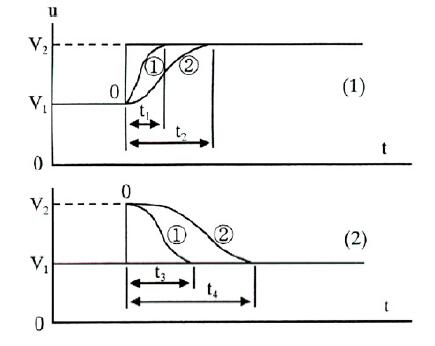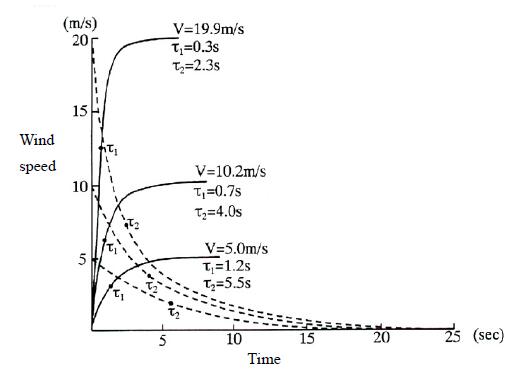The response characteristics of an anemometer are determined by its starting threshold and its damping oscillation properties. An anemometer that immediately starts to rotate when the wind starts blowing and immediately halts when the wind stops is said to have good response characteristics. In the case of rotating anemometers, however, the mechanism does not allow the frictional force of the rotating axis to be reduced and the moment of inertia cannot be zero; accordingly, delayed response to changes in wind speed occurs. This delay is a source of errors in wind speed measurement.
The response characteristics differ between cases when the wind speed increases and when it decreases; for increases, the response time is shorter than for decreases. Figure below shows the response when the wind speed suddenly increases from V1 to V2. There is a delay of t1 in Curve ① until the indication reaches the level of V2, while Curve ② indicates a delay of t2. If the wind speed suddenly decreases from V2 to V1 as shown in Graph 2, the rotating axis does not stop immediately because of the moment of inertia and the dynamic friction of the rotating axis. As a result, delays of t3 and t4 occur. In both graphs 1 and 2, the response characteristics of Curve ① are better than those of Curve ②. The curves in Graph 1 are called acceleration curves, and those in Graph 2 are called deceleration curves.

A rotating anemometer has response characteristics such as t1 (or t2) < t3 (or t4) in the acceleration and deceleration curves shown in Figure above. As its response is faster when the wind speed increases than when it decreases, the average wind speed it measures is a little higher than the true average.
The response characteristics of anemometers examined in a wind tunnel are shown in Figure below, in which the solid lines show acceleration curves and the broken lines show deceleration curves at 5 m/s, 10 m/s and 20 m/s, respectively. τ1 and τ2 are the time constants for each wind speed when the speed increases and decreases, respectively. As described above, τ1 is generally smaller the τ2. Provided that the wind speed is v and the time delay factor is the time constant τ, the value (v × τ) remains almost constant, and is termed the response length. As the time constant of an anemometer varies with the wind speed and whether it increases or decreases, the response characteristics cannot be evaluated from the time constant alone. Accordingly, the response length is used as a measure to determine these characteristics. The smaller the response length, the better the response characteristics of the anemometer.

